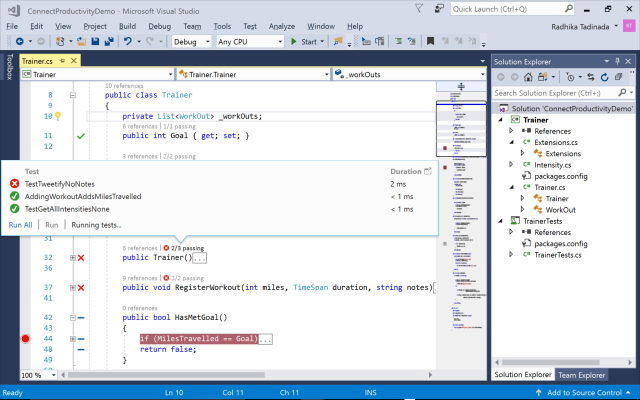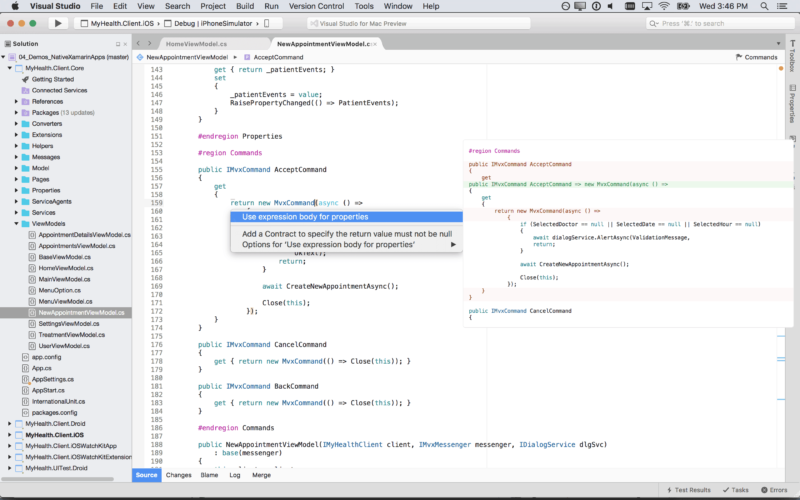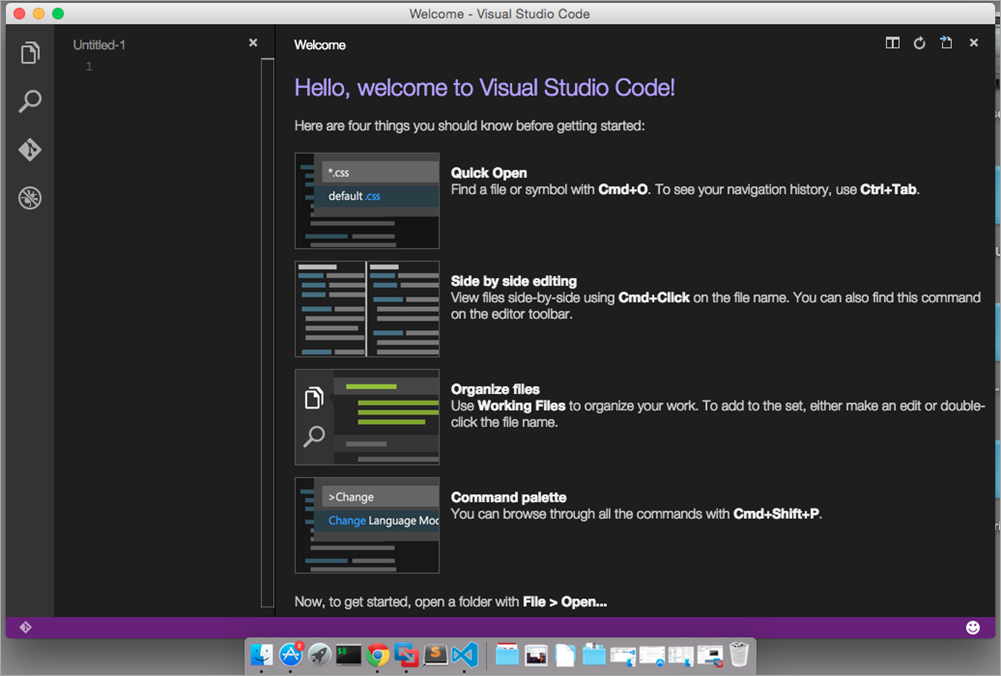Visula Studio For Mac
Visual Studio for Mac enables the creation of.NET Core solutions, providing the back-end services to your client solutions. Code, debug, and test these cloud services simultaneously with your client solutions for increased productivity.
Microsoft recently released Visual Studio Code and I am a little confused about its usage, since Visual Studio has lot of similarities functionally with it.
Steven M. Vascellaro6 Answers
Visual Studio (full version) is a 'full-featured' and 'convenient' development environment.
Visual Studio (free 'Express' versions - only until 2017) are feature-centered and simplified versions of the full version. Feature-centered meaning that there are different versions (Visual Studio Web Developer, Visual Studio C#, etc.) depending on your goal.
Visual Studio (free Community edition - since 2015) is a simplified version of the full version and replaces the separated express editions used before 2015.
Visual Studio Code (VSCode) is a cross-platform (Linux, Mac OS, Windows) editor that can be extended with plugins to your needs.
For example if you want to create an ASP.NET application using VS Code you need to perform several steps on your own to setup the project. There is a separate tutorial for each OS.
Jenny O'ReillyJenny O'ReillyVisual Studio Code is an editor while Visual Studio is an IDE.
Visual Studio Code is cross-platform and fast, while Visual Studio is Windows/Mac only and not fast.
Note that Visual Studio for Mac is available now but is a different product compared to Visual Studio (Windows). It's based on Xamarin Studio and lacks support for some older .NET project types. It does successfully build solutions created in VS 2017. VS mac has a more limited UI (for example, no customizable toolbar). So for cross-platform work. VS Code may still be preferable.
DaveInCazI will provide a detailed differences between Visual Studio and Visual Studio Code below.
If you really look at it the most obvious difference is that .NET has been split into two:
- .NET Core (Mac, Linux, and Windows)
- .NET Framework (Windows only)
All native user interface technologies (Windows Presentation Foundation, Windows Forms, etc.) are part of the framework, not the core.
The 'Visual' in Visual Studio (from Visual Basic) was largely synonymous with visual UI (drag & drop WYSIWYG) design, so in that sense, Visual Studio Code is Visual Studio without the Visual!
The second most obvious difference is that Visual Studio tends to be oriented around projects & solutions.
Visual Studio Code:
- It's a lightweight source code editor which can be used to view, edit, run, and debug source code for applications.
- Simply it is Visual Studio without the Visual UI, majorly a superman’s text-editor.
- It is mainly oriented around files, not projects.
- It does not have any scaffolding support.
- It is a competitor of Sublime Text or Atom on Electron.
- It is based on the Electron framework, which is used to build cross platform desktop application using web technologies.
- It does not have support for Microsoft's version control system; Team Foundation Server.
- It has limited IntelliSense for Microsoft file types and similar features.
- It is mainly used by developers on a Mac who deal with client-side technologies (HTML, JavaScript, and CSS).
Visual Studio:
- As the name indicates, it is an IDE, and it contains all the features required for project development. Like code auto completion, debugger, database integration, server setup, configurations, and so on.
- It is a complete solution mostly used by and for .NET related developers.It includes everything from source control to bug tracker to deployment tools, etc. It has everything required to develop.
- It is widely used on .NET related projects (though you can use it for other things). The community version is free, but if you want to make most of it then it is not free.
Visual Studio is aimed to be the world’s best IDE (integrated development environment), which provide full stack develop toolsets, including a powerful code completion component called IntelliSense, a debugger which can debug both source code and machine code, everything about ASP.NET development, and something about SQL development.
In the latest version of Visual Studio, you can develop cross-platform application without leaving the IDE. And Visual Studio takes more than 8 GB disk space (according to the components you select).
In brief, Visual Studio is an ultimate development environment, and it’s quite heavy.
Reference:https://www.quora.com/What-is-the-difference-between-Visual-Studio-and-Visual-Studio-Code
Peter MortensenVisual Studio For Mac Tutorial
Complementing the previous answers, one big difference between both is that Visual Studio Code comes in a so called 'portable' version that does not require full administrative permissions to run on Windows and can be placed in a removable drive for convenience.
Peter Mortensen
Visual Studio
- IDE
- Except for free editions, it is a paid IDE.
- It is quite heavy on CPU and lags on lower end PCs.
- It is mostly used for Windows software development including DirectX programs, Windows API, etc.
- Advanced IntelliSense (best one ever; Visual Studio Code's IntelliSense extension takes second place)
- It features built-in debuggers, easy-to-configure project settings (though developers tend to not use the GUI ones)
- Microsoft support (more than Visual Studio Code)
- Mostly used for C/C++ (Windows), .NET and C# projects along with SQL Server, database, etc.
- Extreme large download size, space utilization and the slow downs over time.
- It is the only con that forces me to use Visual Studio Code for smaller projects*
- Includes tools to generate dependency graphs. Refactoring tools have great support for Visual Studio.
- Has a VYSIWYG editor for VB.NET, C++.NET, and C#. (It is easy enough for first time users instead of getting through
windows.h)
Visual Studio Code
- Free open source text editor
- Has IntelliSense (but it doesn't work out of box if Visual Studio is not installed, need to configure to point to MinGW, etc.)
- Smaller download size and RAM requirements. With IntelliSense it requires around 300 MB RAM. (Edit : Some header files tend to blow up memory requirements to 7-8 GBs eg. OpenGL and GLM Libraries)
- It works on lower-end PCs. (it is still slow to start up especially if PowerShell is used instead of CMD)
- Lower support (open source, so you can modify it yourself)
- Build tasks are project specific. Even if you want to build it in a vanilla configuration.
- Mostly used for web development (this applies to all free text editors). They tend to show off JavaScript / HTML support over C/C++. Visual Studio shows off Visual Basic/C++ over other languages.
- Lack of good extensions (it's still new though)
- Gives you a hard time to reconfigure your project/workspace settings. I prefer the GUI way.
- Cross platform
- Has an integrated terminal (PowerShell is too slow at startup though)
- It is best for smaller projects and test code (you know if you are bored and want to print 'Hello, World!', it does not make sense to wait 3-5 minutes while Visual Studio loads up, and then another minute or 2 at project creation and then finally getting it to print 'Hello, World!').
Visual Studio For Mac Tutorial
Visual Studio Code is integrated with a command prompt / terminal, hence it will be handy when there is switching between IDE and terminal / command prompt required, for example: connecting to Linux.
Peter Mortensenprotected by Community♦Nov 17 '18 at 1:09
Thank you for your interest in this question. Because it has attracted low-quality or spam answers that had to be removed, posting an answer now requires 10 reputation on this site (the association bonus does not count).
Would you like to answer one of these unanswered questions instead?
Not the answer you're looking for? Browse other questions tagged visual-studiovisual-studio-code or ask your own question.
-->| Developer Community| System Requirements| Compatibility| Distributable Code| License Terms| Blogs| Known Issues |
Overview
This page contains the minimum system requirements for the Visual Studio 2017 family of products. For information on compatibility, see Visual Studio 2017 Platform Targeting and Compatibility. If you need help with improving performance, see Visual Studio performance tips and tricks.
What's New
See what's new in Visual Studio 2017!
- For Windows, Visual Studio IDE, the Visual Studio 2017 release notes, or What's New in Visual Studio 2017.
- For Mac, What’s New in Visual Studio for Mac or the Visual Studio 2017 for Mac release notes.
- Visual Studio Team Services.
- Visual Studio Code or the VS Code release notes.
Download
Click a button to download the latest version of Visual Studio 2017. For instructions on installing and updating Visual Studio 2017, see the Update Visual Studio 2017 to the most recent release. Also, see instructions on how to install offline.
Visual Studio For Mac Unity
Visit the visualstudio.microsoft.com/downloads page to download other Visual Studio 2017 products.
Note
Installation package size will vary depending on your current Visual Studio configuration.
Tip
For older versions of Visual Studio, see the system requirements for Visual Studio 2015, Visual Studio 2013, or Visual Studio 2012.
Feedback
We would love to hear from you! For issues, let us know through the Report a Problem option in the upper right-handcorner of either the installer or the Visual Studio IDE itself. The icon is located in the upper right-hand corner.You can track your issues in the Visual Studio Developer Community, where you can ask questions and find answers.You can also make a product suggestion through Developer Community or get free installation help throughour Live Chat support.
Visual Studio 2017 System Requirements
The following products support the minimum system requirements below:
- Visual Studio Enterprise 2017
- Visual Studio Professional 2017
- Visual Studio Community 2017
- Visual Studio Team Explorer 2017
- Visual Studio Test Professional 2017
- Visual Studio Test Agent 2017
- Visual Studio Test Controller 2017
- Visual Studio Team Foundation Server Office Integration 2017
- Visual Studio Feedback Client 2017
Supported Operating Systems | Visual Studio 2017 will install and run on the following operating systems:
|
Hardware |
|
Supported Languages | Visual Studio is available in English, Chinese (Simplified), Chinese (Traditional), Czech, French, German, Italian, Japanese, Korean, Polish, Portuguese (Brazil), Russian, Spanish, and Turkish. You can select the language of Visual Studio during installation. The Visual Studio Installer is available in the same fourteen languages, and will match the language of Windows, if available. Note: Visual Studio Team Foundation Server Office Integration 2017 is available in the ten languages supported by Visual Studio Team Foundation Server 2017. |
Additional Requirements |
|

Visual Studio Team Foundation Server 2017
For detailed information on system requirements for various deployment scenarios, and for information onintegration with Microsoft Office and Microsoft SharePoint, seeVisual Studio Team Foundation Server Requirements and Compatibility.
The following products support the minimum requirements below:
- Visual Studio Team Foundation Server 2017
- Visual Studio Team Foundation Server Express 2017
Supported Operating Systems | Visual Studio Team Foundation Server 2017 will install and run on the 64-bit versions of the following operating systems:
|
Hardware | For hardware recommendations on single-server and multi-server deployments, see Visual Studio Team Foundation Server Requirements and Compatibility. |
Supported Languages | Visual Studio Team Foundation Server is available in the following languages:
|
Additional Requirements |
|
Microsoft Visual Studio 2017 for Mac
To download Visual Studio for Mac, see visualstudio.com/vs/visual-studio-mac.
Tip
For more information, see Visual Studio 2017 for Mac release notes, Visual Studio 2017 for Mac Product Family System Requirements, and Visual Studio 2017 for Mac Platform Targeting and Compatibility.
Microsoft Visual Studio Code
To download Microsoft Visual Studio Code, see code.visualstudio.com.
Tip
For more information, see Requirements for Visual Studio Code,the release notes, and Visual Studio Code FAQ.
Remote Tools, Performance Tools, and IntelliTrace Standalone Collector for Visual Studio 2017
The Remote Tools, Performance Tools, and IntelliTrace Standalone Collector support the same system requirements as Visual Studio with the following changes:
- Also installs on Windows 10 Enterprise LTSC, Windows Server 2012, and Windows Server 2008 R2 SP1
- Requires a 1.6 GHz or faster processor
- Requires 1 GB of RAM (1.5 GB if running on a virtual machine)
- Requires 1 GB of available hard disk space
- Requires 1024 by 768 or higher display resolution
- For the best experience, use the most recent update of these diagnostic tools for your version of Visual Studio
Microsoft Visual Studio Build Tools 2017
The Build Tools support the same system requirements as Visual Studio with the following changes:
- Also installs on Windows Server 2008 R2 SP1 and on the Server Core option for Windows Server 2016.
- Also installs into a Windows container.
- Requires 2.3 GB to 60 GB of available hard disk space, depending on installed features.

Microsoft Visual C++ Redistributable for Visual Studio 2017
To download the Visual C++ Redistributable, see visualstudio.microsoft.com/downloads.
The Visual C++ Redistributable supports the same system requirements as Visual Studio with the following changes:
- Also installs on Windows 10 Enterprise LTSC, Windows Server 2012, Windows Server 2008 R2 SP1, Windows Vista SP2, Windows Server 2008 SP2, Windows Server 2003 SP2, and Windows XP SP3
- Requires 1 GB of RAM (1.5 GB if running on a virtual machine)
- Requires 50 MB of available hard disk space